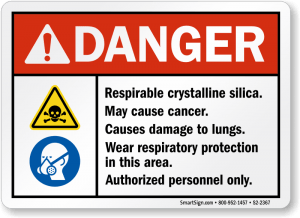Silica is a deadly material that can severely damage the lungs if you are exposed. On February 5th, 2020, OSHA has taken further steps to help reduce exposure to silica for workers in an OSHA trade release. We want to quickly go over a few of the dangers when exposed to silica, and then cover the document and identify some of the changes made to the National Emphasis Program.
Silica is made up of minerals found in the Earth, which ranges from sand to concrete and more. The worry when dealing with silica is breathing in the small particles not visible to the human eye, and only a little amount can introduce potential health hazards and disturb the well-being of your body. These health hazards are very fatal, including lung cancer, kidney disease, and more. One major disease is called silicosis, which is debilitating and leads to death. At present, there are no known cures for silicosis. 
Since we ran through why you should avoid exposure to silica, we will cover a few of the changes to the NEP. Specifying general industry, maritime, and construction, the NEP decreases the limit of exposure to 50 micrograms per cubic meter for an 8-hour time period. This means less material is allowed to enter your system during a given workday, which decreases the likelihood of a possible exposure incident.
Lastly, there are two more changes dealing with OSHA offices and state plans. For OSHA offices, they must follow the new NEP updates, and they are not required to create and use similar regional or local emphasis programs for use. For State Plans, they must join in, due to the nationwide exposure to silica around the country.
These changes provide further protection to workers who may have otherwise been exposed to amounts of silica exceeding the guidelines set forth in different industries across the United States. OSHA is taking further steps to find out what they can do to aid in worker safety.
 If you have more questions about the revised National Emphasis Program, you can check out the OSHA website or contact us! When dealing with dangerous materials and hazards such as silica, there is no room for error, and we should only be working to improve our standards and work environments.
If you have more questions about the revised National Emphasis Program, you can check out the OSHA website or contact us! When dealing with dangerous materials and hazards such as silica, there is no room for error, and we should only be working to improve our standards and work environments.

